Could you use critical data to support your manager’s development? Then FinxS® Management 52 is for you.
Continue reading “FinxS® Management 52 Tool: Developing Managers into Leaders”
Continue reading “FinxS® Management 52 Tool: Developing Managers into Leaders”
Continue reading “Starting Off Strong: Using DISC in Onboarding”
DISC sales sessions help your salespeople be more productive and sell more successfully. The key is finding the balance between learning, practice, and application. Here are a few tips, activities, and resources to deliver your best sessions yet.
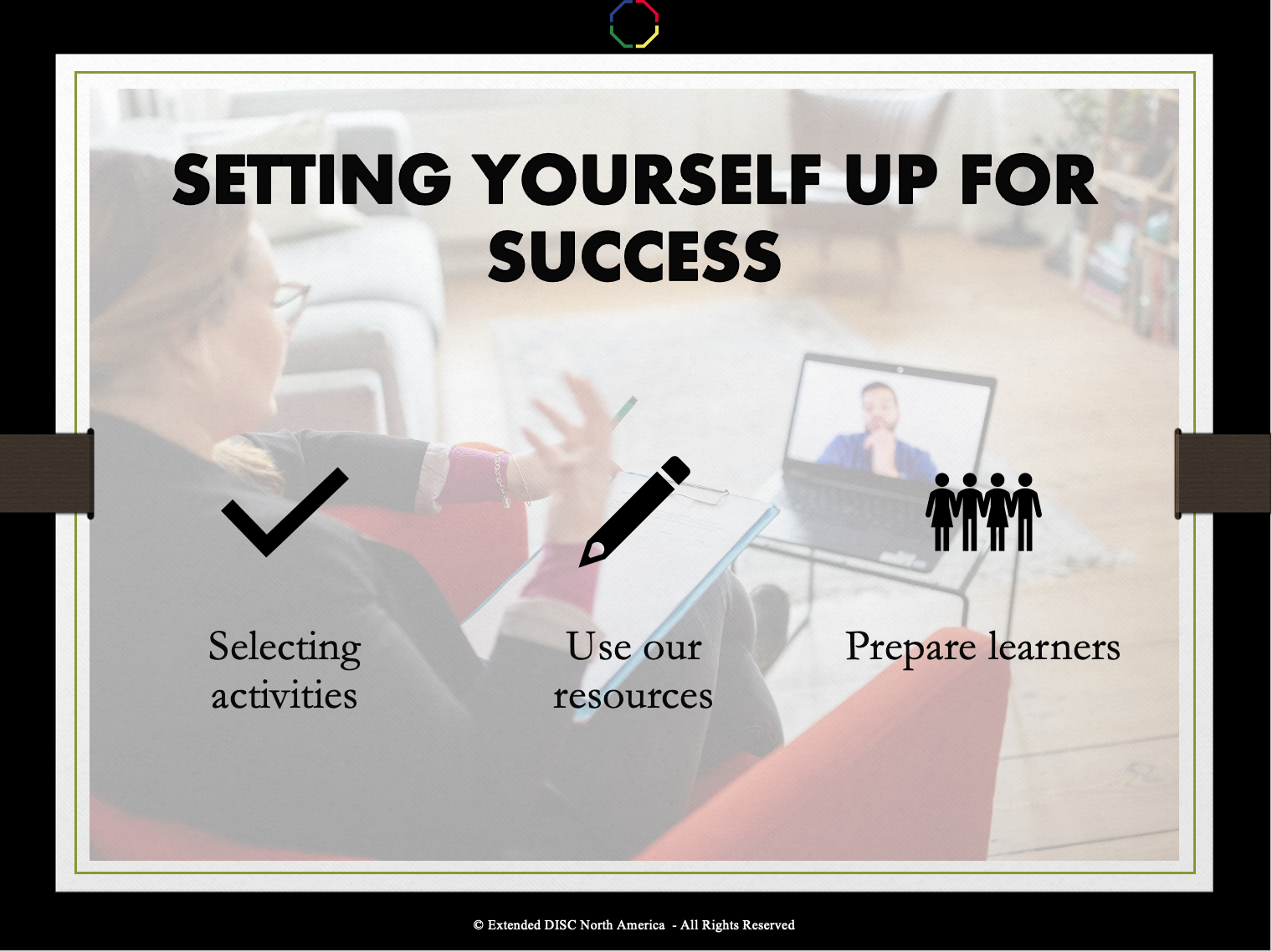
Involve people and turn on the energy level early on. How? Start with a warm up activity! Try asking a simple set of questions that connect them to their DISC results. For example:
Or, ask your salespeople to select a quote they connect to. Use quotes that work for your group. What would you choose from the following?
– Confucius, Chinese Philosopher
Buyers don’t believe anything you have to say to them about your product or service until they first believe in you.
– Deb Calvert, The Sales Experts Channel founder
A straightforward way to show buyers that you genuinely like them is to identify something about them that you sincerely appreciate.
– David Hoffeld, Scientific Sales Trainer
If you really look closely, most overnight successes took a long time.
– Steve Jobs, founder of Apple
If you want to succeed you should strike out on new paths, rather than travel the worn paths of accepted success.
– John D Rockefeller, American business magnate
There are no right or wrong or better or worse answers. What’s important is it’s a start to building self-awareness of one’s selling style and relating their choices to DISC style. Tie in the warm-up activity to the session by revisiting their answers in different parts of the workshop.
Make the most of your session by being prepared, selecting activities to support your training goals, and preparing your learners. What other aspects should you consider to maximize your session? For today, let’s focus on assessment tools and activity examples.
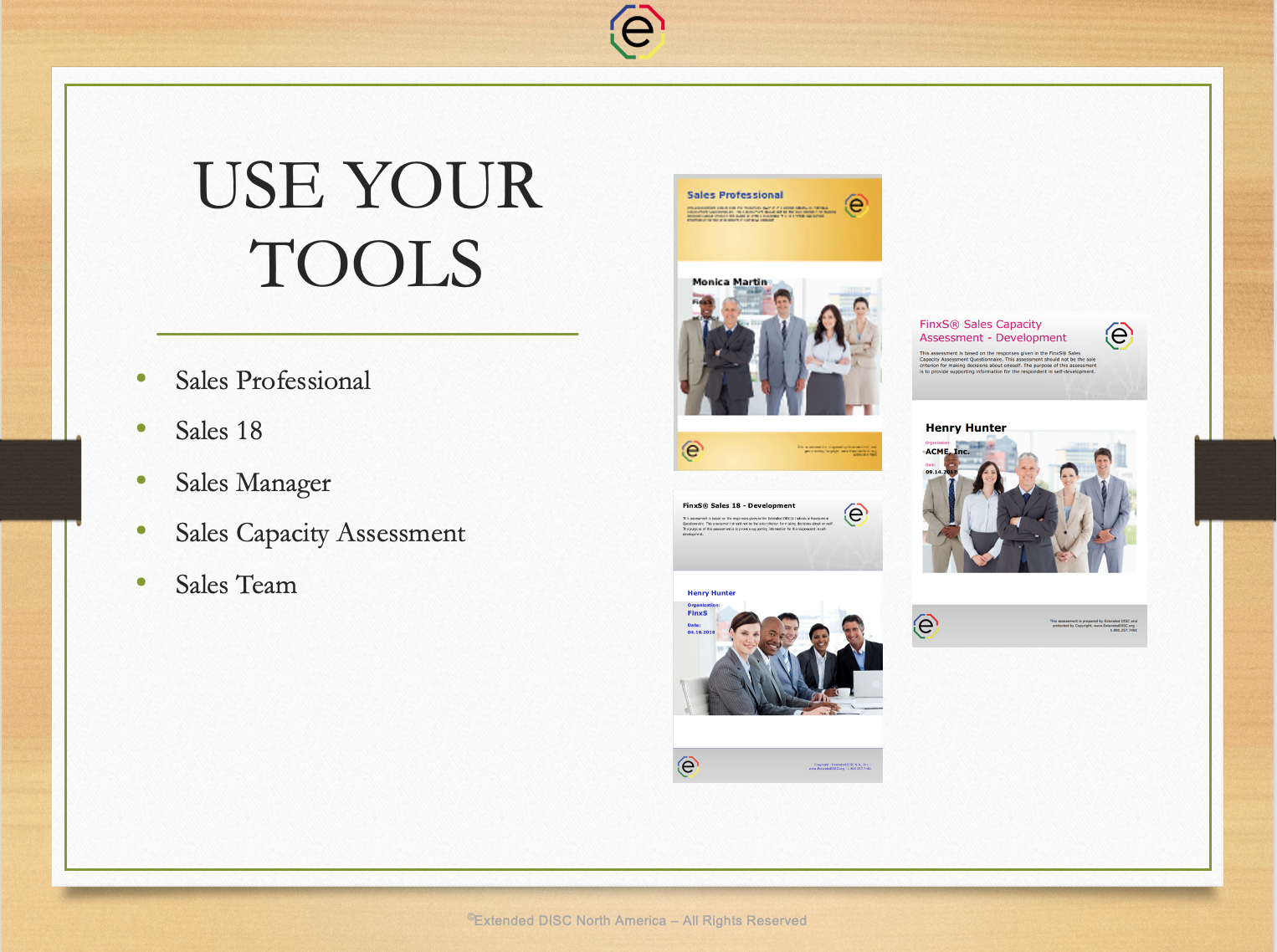
Don’t reinvent the wheel. Your job is challenging enough. Instead, build simple and applicable training using the resources provided at Extended DISC and customize them to fit your training goals. DISC is usually one of many tools in your tool box.
Extended DISC® suite of sales assessments help you build your training. The reports are not just delivering valuable data, but also creating opportunities to evaluate your behavioral sales style and your sales process capacity.
The Sale Professional Assessment builds confident self-awareness. In addition, it helps create your unique ways of adjusting your style for increased sales success. It can be specific for your sales managers and your sales teams.
Sales 18 identifies your natural comfort levels in 18 critical sales competences. These same 18 competences in the Sales Capacity Assessment are used to identify your current sales strengths and development areas.
The report has key questions and activities to help people understand their results, build self-awareness, and apply their learning.
A simple report exercise is to revisit the describing yourself and how your sales styles might be described by your prospects activity and compare it to the ‘at a glance’ section. The ‘at a glance’ section in the Sales Professional report describes how your sales style is typically seen by others. Your blind spots, the gap between how you see your style versus how others see your style, is often the greatest opportunity for development.
Review the reports from a trainer perspective. How can you use the reports to support your salespeople?

Moving your group to action is an effective way to transfer learning into real world situations.
Don’t forget to practice identifying the DISC styles. Try pairing people off or have them work in small groups. Next, have them choose a client or prospect to identify their DISC styles based on observed patterns of behaviors. It not only helps get a clearer view of styles, but also provides more insight about key people.
Role playing is not new in training. It can be energizing for some and less comfortable for others. However, it’s an opportunity to practice difficult and less natural situations. As a trainer, take some time to learn about your salespeople’s common sales situations or don’t hesitate to ask them to volunteer common situations that tend to challenge them. Next, ask them to role play these situations in a learning setting. Debrief the situation and remind them debriefing real sales interactions is an opportunity to learn and develop.
Don’t forget to address the increasing virtual sales setting. Create role playing about sales and virtual calls, and emails. Can you identify styles in emails and phone calls? Which styles prefer emails over calls and vice versa?
Try trivia apps such as Kahoot® or Quizizz® (not endorsing – just a couple examples). You can create fun quizzes and have people compete for bragging rights. They can be great energizers and usable in remote or in person settings! You can have a few quizzes ready to insert an energy boost whenever you need one.
Activity sections are where the learning comes to life so make them plentiful.
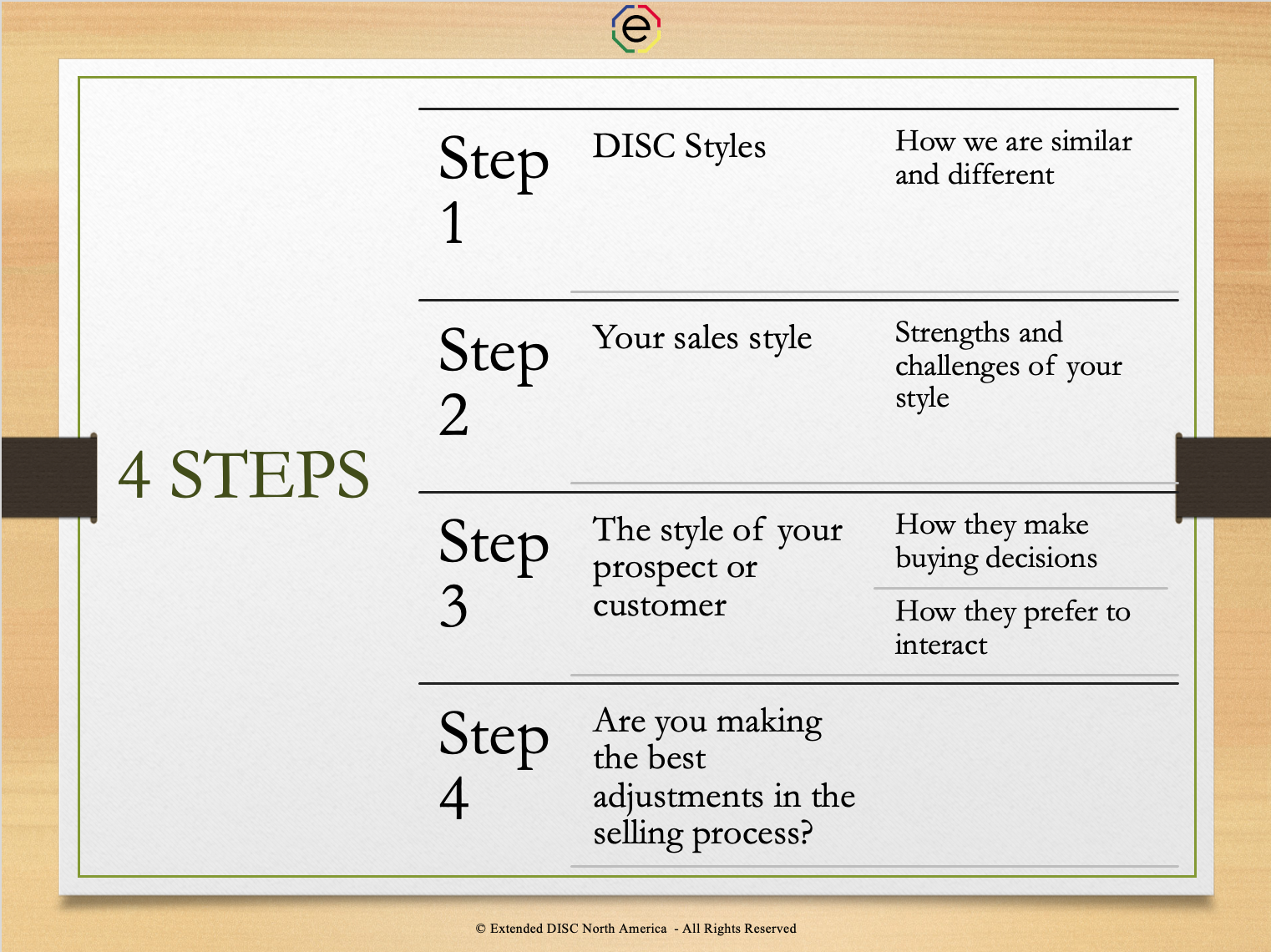
The 4 Steps to Effective Interactions template includes the basic and key learning points. It helps you reach your training goals. Step 4 puts the first 3 Steps into practice by creating a behavioral action plan.
Give your salespeople the gift of DISC. Are you ready?
 Are you sad to be putting away your home office loungewear? Are you trying on your work clothes; albeit a little tighter? It’s that time.
Are you sad to be putting away your home office loungewear? Are you trying on your work clothes; albeit a little tighter? It’s that time.
Companies are transitioning their employees back to the office. Unlike last year’s abrupt switch to remote work, there’s more time reopening the offices.
Upon opening, you can assume office interactions will change. Teams may work in hybrid settings. You may have employees, who were remotely hired and have never had a face-to-face interaction with their team. Some team members may return to the office and others may continue to work remote.
There’s still a lot of uncertainty happening and more changes to come. How can you help, and possibly even enhance, productivity and connectivity during these times? DISC helps you recognize the different transition needs of your employees. How are they likely to respond to changing environments? How can you facilitate change in ways your employees respond better?
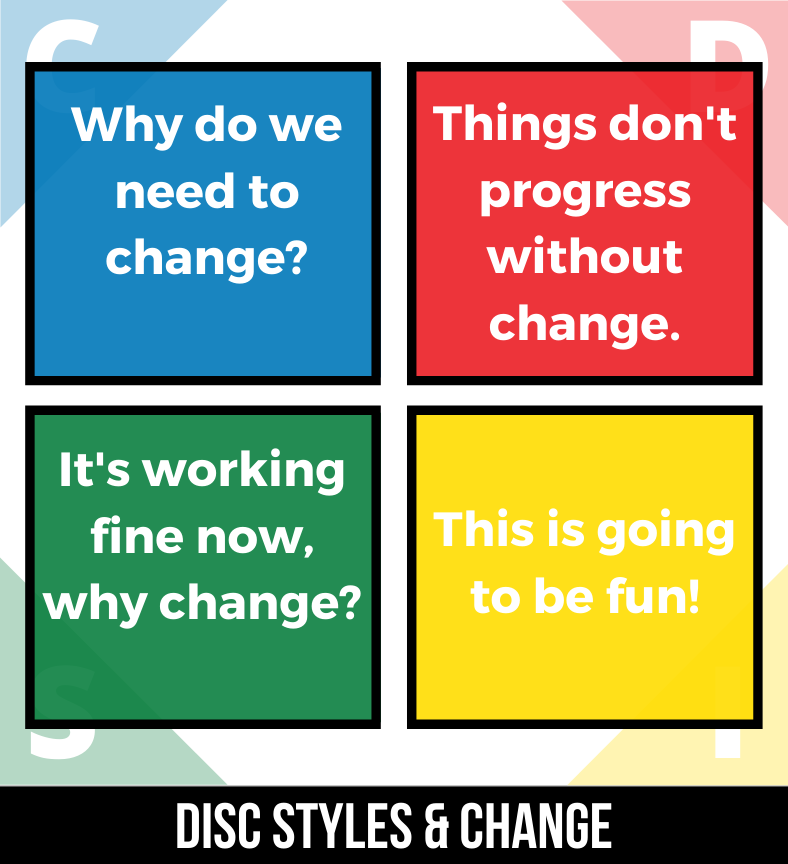
Communication and interactions will change. The new office setting may likely be a combination of office workers, remote workers, and hybrid workers. Virtual meetings and office messaging may be as standard as break room chats.
DISC helps you understand how different styles react to change since it’s not the same for everyone. The thought of going back to the office may be thrilling and energizing for some people and for others they may dread the face-to-face interactions. Some miss the hustle and bustle of the office and the ability to get things done quickly in person. Others miss the daily chit chats and opportunities for many interactions. Still, others may need things to slow down and need to be given a clearly laid out plan.
Let’s look at styles and change to understand the differences.
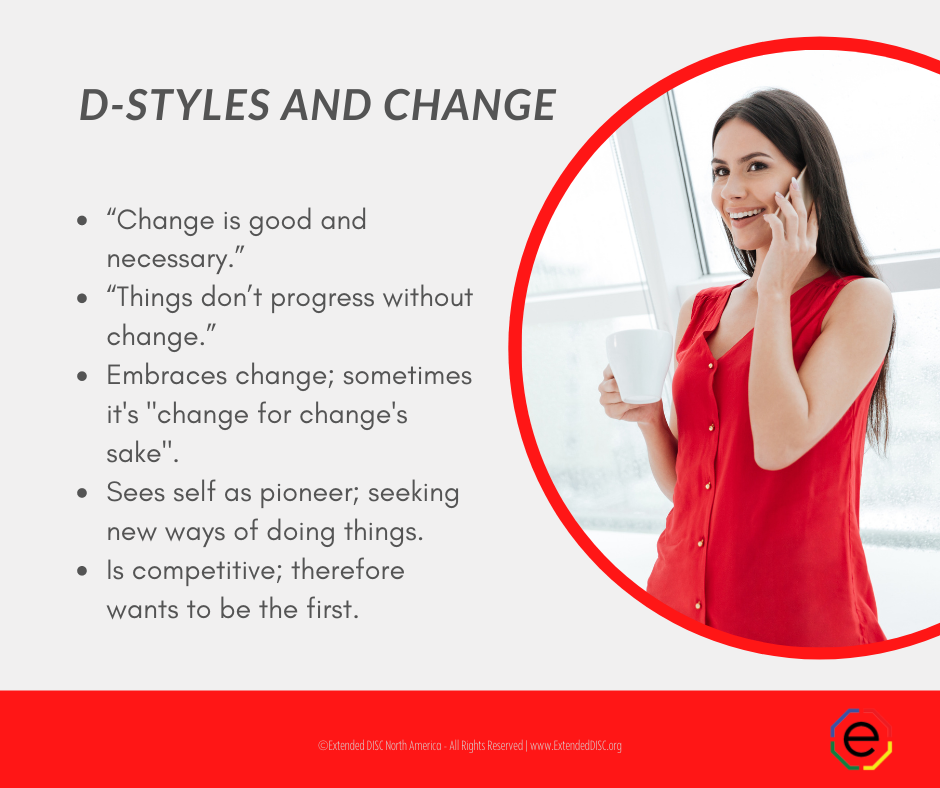
D-styles approach change as good and necessary, ‘things don’t progress without change.’ Your D-styles are more likely to embrace change; simply for change’s sake. They may see themselves as a pioneer looking for new opportunities and new ways of doing things. Their competitiveness drives them to be on the forefront of change.
As long as it serves your D-styles in accomplishing their tasks, they will be a ‘yay’ in returning to the workplace. The ability to network and achieve faster resolutions are motivating factors. They may have enjoyed the independence of working from home; however, ensure they still have opportunities to to make their own decisions and they will be happy. Help them manage the challenges of multi-tasking that works for the whole team. D-styles may need to challenge themselves to adjust their pace of change to support their team’s productivity.
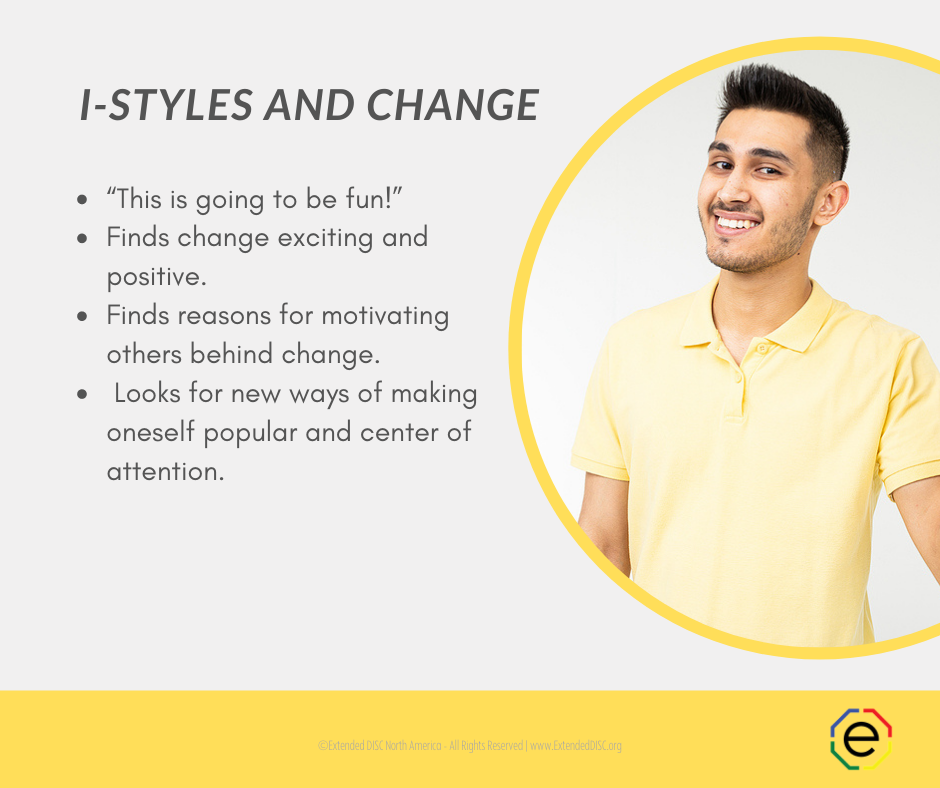
I-styles will likely be an excited ‘yay’ in returning to the office, since they tend to view change positively, ‘this is going to fun!’ They’ll be excited to be back at work and have the chance for many spontaneous interactions with their team. They may see it as an opportunity to have more attention focused on themselves.
I-styles can find reasons for motivating their team members behind change and help set the tone for the team. Build in flexibility. Ensure your I-styles have opportunities to network and bring the team together in a fun and positive way. Don’t let them get too distracted by all the changes or they may overlook the details and tasks.
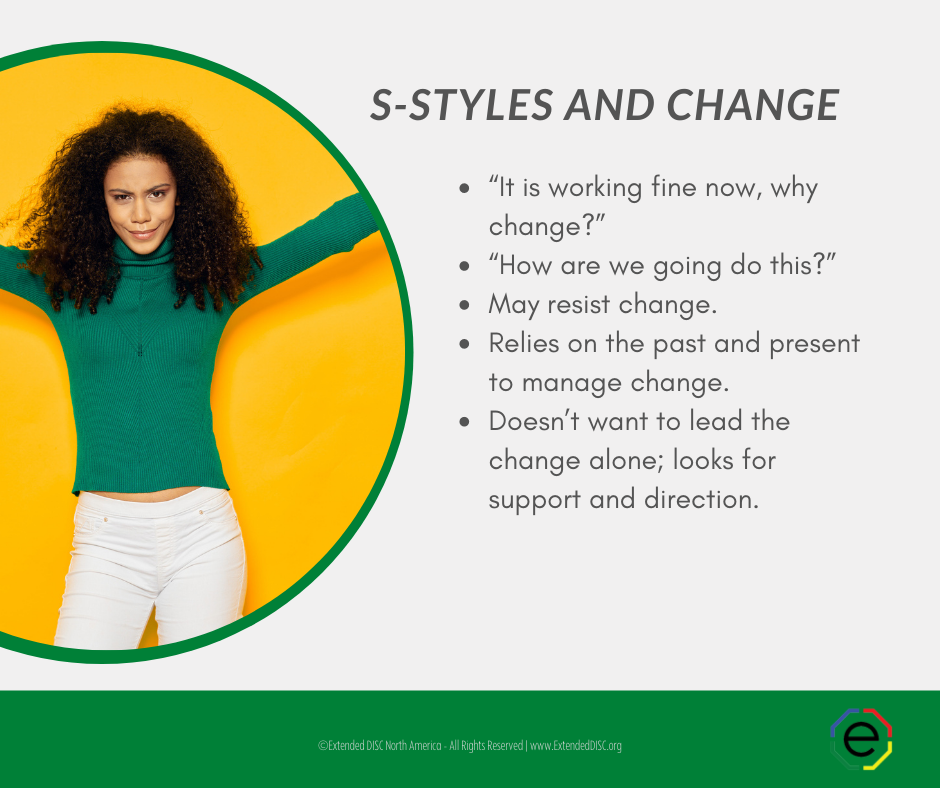
S-styles may feel like they just settled in to the remote work routine; it took a while. They may feel anxious about the change process and may even resist it. They may be the ‘ugh’ in returning to the office because they have established a remote work routine.
Remember to provide as much planning and direction as possible. Give them time to transition and check in with them to see how they’re doing. They may not speak up if something is bothering them. Give them time to bond and build rapport with their team and provide support and guidance one-on-one whenever possible. Their flexibility needs may lie in their work-life balance; do they have clearly delineated flexibility to manage home-school kids or pets?

Your C-styles will want to understand why the change is needed at this time. They want information and facts. C-styles, in the face of change, will move cautiously and systematically. They may even want to test the initial effects of the change before proceeding further.
Address their questions carefully. For example, clearly lay out the post-pandemic safety policy; even better if you send it in writing. Provide a schedule and time to transition. Provide clear reasons why returning to work at this time is logical. For example, they have a dedicated space to focus and technology and data may be easier to access.
For some it feels like starting over and that can be a great thing or it can feel uncomfortable. Recognizing that each person on your team does not approach change and transition the same way is the important first step. Next, is recognizing what alleviates stress in change situations, and then take the steps necessary to do it.
Ultimately, be kind to yourself. This transition is a step closer to your new normal.